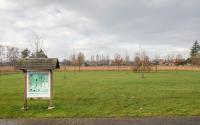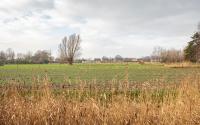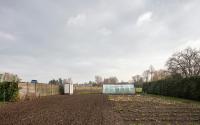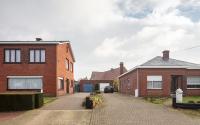Beveren - Groothuiswijk Verrebroek
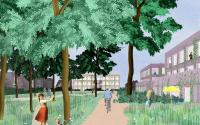
Award

51N4E bvba
Download design proposalThe study assignment for a master plan for the expansion and future redevelopment of the Groothuis neighbourhood in Verrebroek, Beveren was awarded to 51N4E bvba in collaboration with Plant en Houtgoed bvba and Zero Emission Solutions.
From rural allotment to neighbourhood garden district in Verrebroek
The master plan is based on three principles: better social space, adaptable housing and green open space. For the realization of the necessary extra housing, the designers propose not carving out a new open space but starting from the existing one. After all, there is no justification for cutting into the water-sensitive open space area, even though it is zoned for residential expansion. With their proposal the designers want to demonstrate that densification is the condition for a social and ecological quality leap.
This densification offers opportunities to affordably renovate the existing housing and to upgrade the open space. It also offers the possibility of adding new, more flexible and diverse forms of housing, anchored in a robust green and qualitative framework. By compacting the building mass, by topping up existing homes or by replacing garages with new buildings, this design proposal aspires to reduce the CO2 emissions of the construction project.
The subdivision is transformed into a garden suburb. The enhancement of the open space into a green landscape creates a new, attractive, climate-robust identity. In this way, a residential area is created that has the qualities of a village, with space for encounters. A range of different housing types will be developed, in relation to the different types of open spaces. The residents’ sense of belonging is strengthened by the relationship that they enter into with ‘their’ street, ‘their’ court, ‘their’ square. The social space provides sufficient gradients between private and public, with natural elements. In this way the residents are encouraged to make more (shared) use of the environment. The connections with Verrebroek, the surroundings and the neighbourhood garden improve the interactions and activate the social life of the residents.
To meet long-term needs, the master plan offers flexible housing typologies that respond to the needs of an evolving community. The green layout builds on what is present today and makes the place an attractive environment for living and relaxing.
The open space is clearly demarcated and marked in relation to the built environment. The landscape is accessible and is traversed by walking and cycling paths. It is a polder landscape with micro-reliefs, which is used to create a floodable landscape. The open space becomes a real open space where activities for the neighborhood can be organized in relation to the landscape. The plan includes a very clear concept about land use, creating a natural area with high ecological and functional value, connecting the neighborhood and the open space.
Translated with www.DeepL.com/Translator (free version)
Selection

BRUT, LAND landschapsarchitecten
Download design proposal
Woonwerk Architecten
Download design proposalProject description
The Regional Housing Society GMH wishes to have a master plan drawn up for the expansion and redevelopment of the existing Groothuiswijk in Verrebroek. This residential area comprises 50 ground-level social housing units with an adjoining undeveloped plot of land located in a residential expansion area (5 ha). The district was built in the 1970s. The housing units are still habitable and are to be renovated according to the E60 energy standard. It is unclear whether these units will be able to meet the target of being climate-neutral by 2050.
Although Verrebroek is a rural municipality, it is a sought-after location. As a direct neighbour, the port is an asset in terms of employment. In the past, an allotment plan was drawn up for the adjoining residential expansion area, but this plan envisaged a development with about a hundred terrace houses and semi-detached buildings. The commissioning authority wishes to abandon this approach and develop a housing model with a future on these grounds. This means compact volumes and stacked houses, with a long-lasting shell. We are looking for a mix of housing sizes and a concept that makes future adjustments possible. We are envisaging a compact construction, with three or four storeys, so that the same number of dwellings occupy only a quarter or at most a third of the area due to their small footprint. This should ultimately allow for open space to remain available for short-chain agriculture and/or horticulture.
Only in order to introduce an innovative, CO2-neutral housing model is it still acceptable to build a greenfield. The aim here is to create a residential ensemble that helps to make Flanders climate neutral. The master plan must also allow for a phased approach, with an initial phase of up to 50 housing units to be carried out. This phase must also potentially be a final phase. The concept must also be able to serve as a model for the replacement of the existing 50 houses if ever they need to be replaced at this location in the long term.
This new housing model requires ‘rural-urban’ architecture: architecture that seeks to translate the necessary density into the qualities and charms of village life. The designers must reconcile the increase in density with the scale and morphology of the polder village, thus making a positive contribution to the identity of Verrebroek.
Selection criteria
- The general design-based expertise with regard to the project assignment
- Professional competence
- Relevant experience
Award criteria
- The quality of the concept and vision development and the design research in light of the ambitions and expectations of the commissioning authority as formulated in the specifications
a. In a broad social context
b. Applied more functionally to the practical requirements of the user - The approach to integrated sustainability
- The estimate of the project cost including an estimate of the services planned in the process of the various experts within the fixed-sum fee
- The team composition
- Process-orientation and process-readiness
The weighting of the respective criteria has been determined as follows: 4/3/2/1/1. The subcriteria have the same weighting.
Downloads
Project details
Project code
OO4108
Official name
Study assignment for a master plan for the expansion and future redevelopment of the Groothuiswijk in Verrebroek, Beveren
This project is part of the project bundle OO41.
Status
Awarded
Client
Gewestelijke Maatschappij voor Huisvesting
Site location
Pastoor Jasparsstraat
9130 Beveren
Belgium
Area between Pastoor Jasparsstraat, Rijkstraat, Walestraat and Sint-Laurentiusstraat
Timing project
- Selection meeting:
- First briefing:
- Second briefing:
- Deadline offers:
- Jury:
Contactperson client
Karin Beeldens
Contact Team Vlaams Bouwmeester
Christa Dewachter
Award procedure
Competitive procedure with negotiation
Financial
Commission
Fee for offers
Project type
Function
Domain
This project was realized via Open Oproep. Read more about this tool.
Last reviewed on: .








